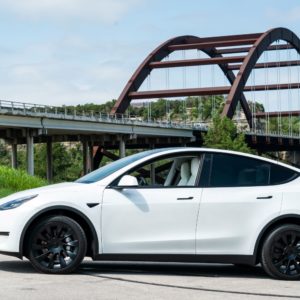Despite its advanced technology, the Tesla Model 3 is notorious for rattling. These strange noises are often caused by components that haven’t been secured properly.
But which components in particular are responsible for making so much noise, and what steps can you take to fix these problems?
What Causes Rattling in the Tesla Model 3?
Typically, rattling in your Tesla Model 3 is caused by footwell problems, improperly fitted trim pieces, loose seat brackets, problems with the struts and ball joints, and loose wires and clips in the door panel.
Footwell Problems
One of the most common causes of rattling in the Tesla Model 3 is a footwell that’s come loose or hasn’t been installed properly. The footwell refers to the space beneath the steering wheel. More often than not, the rattling is caused by the upper panel of the footwell coming loose and rapping against the AC vent as it vibrates.
Improperly Fitted Trim Pieces
When trim pieces aren’t fitted properly, they become loose and make noises as they rap against other surfaces during transit. Because of this, it’s important to make sure the trim pieces of your Tesla are secure and properly installed if you want to avoid dealing with strange rattling noises.
Loose Seat Brackets
Another potential cause for rattling in your Tesla is if the seat brackets aren’t fitted properly. When seat brackets and latches are loose, you might hear strange noises inside the cabin. These noises often become more audible when driving over bumpy roads. More often than not, these sounds will come from the rear seats.
Problems with Struts and Ball Joints
If you hear rattling noises in your Tesla Model 3, it might be a good idea to inspect the struts, control arm bushings, ball joints, and strut mounts of your vehicle. When these components are misaligned or get damaged in any way, they might make clunky noises. If the struts and ball joints require attention, it’s important to get them checked by a mechanic as soon as possible.
Wires and Clips in the Door Panel
When wires and clips inside the door panel come loose, they rattle and rap against other surfaces as you drive. This rattling typically becomes more intense when driving over rough terrain or making sharp turns. Usually, the wires and clips in your Tesla Model 3 come loose when they’re knocked out of place or get misaligned.
How to Fix Rattling Noises in Your Tesla Model 3
Knowing the various causes of rattling noises in your Tesla isn’t enough. It’s also important to know how to fix these problems so you can enjoy comfortable, noise-free drives. The best ways to fix rattling noises include regular maintenance, padding your panels, replacing damaged components, securing loose panels and vents, and tightening the VIN plate.
Get Regular Maintenance
One of the best ways to fix any problem with your Tesla Model 3, rattling noises included, is to bring your vehicle to the shop for maintenance. This way, a professional can inspect your Tesla to see if there’s anything wrong with it and single out potential causes for problems.
Mechanics are trained to diagnose your vehicle and find inoperative components. They can make reliable recommendations on how to fix your rattling problem — and more often than not, they’ll fix it for you too. It’s strongly recommended to follow your manufacturer’s recommended service schedule.
Pad Your Panels
If your Tesla’s panels are responsible for the rattling noise, it might be a good idea to put foam tape or rubber padding on the contact points. You’ll want to pad the interior trim panels and door panels. Not only does this minimize the noise created by rattling components, but it also stops constant vibration and repeated contact, potentially increasing the lifespan of your panels.
Replace Damaged Components
Since damaged components are one of the most common causes of rattling noises in Tesla vehicles, replacing any part of your vehicle that’s broken or inoperative is a good idea. Bad struts, ball joints, and strut mounts need to be addressed, as do worn seals and cracked panels. Wiring that comes loose can also cause rattling.
Secure Loose Vents
Since vents can cause strange noises in your Tesla Model 3, it’s a good idea to inspect them and determine whether or not they’re loose. If the vents are loose, securing them with double-sided tape can help tremendously when it comes to preventing that rattling noise. The AC vent beneath your seat may also be the source of rattling.
Any information provided on this Website is for informational purposes only and is not intended to replace consultation with a professional mechanic. The accuracy and timeliness of the information may change from the time of publication.






































